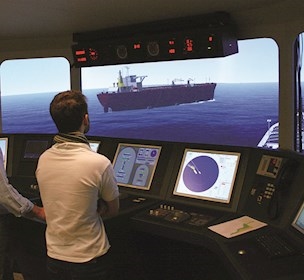Bridge Resource Management
Bridge Resource Management is designed for officers and carried out in a full-mission simulator environment.
Goals and objectives
Bridge Resource Management course is a combined course that includes both
BTM = Bridge Team Management
BRM = Bridge Resource Management
CRM = Crew Resource Management
MRM = Maritime Resource management
EM = Error Managemement
Bridge Resource Management is designed for officers and carried out in a full-mission simulator environment. The course aims at reducing the number of errors as well as their consequences by focusing on the human factors element. Furthermore, it aims at ensuring safety on board by improving deck officers’ ability to manage crisis and emergency situations.
The lessons give an increased knowledge, understanding and attention towards the impact of human factors on board. They will, moreover, create a basis for developing and using BRM skills in the daily routines as well as in emergency situations. In order to improve BRM expertise, the course will contribute to an understanding of the definitions and limitations of BRM skills in order to increase knowledge of methods and tools.
The training is a combination of theoretical and practical exercises and cases. The participants will, during the lessons, gain knowledge of and training in BRM skills in a realistic simulator environment. When using the simulators, the practical exercises reinforce the theory and provide an opportunity to train the participants in entering into a co-operation during routine and critical situations and thereby avoiding emergency situations.
In addition to this, they will develop attention towards their own behaviour and actions. Lastly, the officers will be motivated to exercise new ways of behaviour.
Course description
Bridge Resource Management is a partly classroom-, partly simulator-based course with focus on developing the interpersonal skills of the crew through extensive simulator-based exercises.
Our experienced and certified simulator instructors will ensure that the techniques learned at the classroom-based part of the course are trained in the simulator and thereby transferred to the participants.
The simulator part of the course highlights the need to use modern management techniques if a critical and complex situation on a ship's bridge is to be managed in an optimal way. The exercises give the participants the opportunity to practise in a highly realistic environment with integrated real instruments, back-up systems and handles including joysticks – not to mention the latest graphical computer techniques for the visual system.
Gains
Through our long experience in offering tailor-made training solutions to the maritime industry, we have found that an optimal training sequence in BRM contains specific main subjects:
- The strengths and weaknesses of oral communication – as well as internal and external communication.
- The importance of how to pursue a specific strategy within decision making – as well as within the division of work and responsibilities on the bridge.
- A deep look into how to co-operate with people from other cultures in order to ensure an understanding of cultural differences and language barriers. In addition, the course will introduce specific tools to minimize the effect of different nationalities working together.
- An insight into individual strengths and weaknesses in relation to coping with crisis and emergency situations
In order to ensure an in-depth training, the course also contains other relevant subjects such as:
- Exchange of information on the bridge
- Fatigue, stress and heavy workload and their influence on decision making
- Mental resources
- Crew synergies
- Human error
- Error types and their causes
Turning theory into real-life situations
Case studies will be used during the course as they give an important insight into the theory. We can either use our existing cases, use cases from the client’s own near misses, or accident files combined with the participants' own experience.
The Bridge Resource Management course is aimed at both deck officers and engine officers. Moreover, shore-based line managers directly involved in the operation are encouraged to participate as well.
References: STCW including 2010 Manila amendments, 2017 edition. Table A-II/1 and A-II/2, Section B


